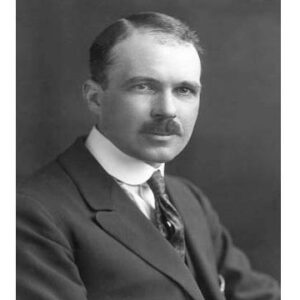William Lawrence Bragg was an Australian-British scientist who, at the age of 25, earned the Nobel Prize in Physics, making him the youngest Nobel Laureate in Physics ever. In 1915, he and his father, William Henry Bragg, were awarded the Nobel Prize in Physics for their work in x-ray crystallography. Despite the fact that he was a gifted and capable young man, it was considered that his father had done the majority of the work and then kindly divided the reward with his son for assisting him. However, it was he who had the key idea and the ability to analyse the diffraction patterns to verify it, and his father had principally contributed to the experiment by developing instruments. The repercussions of this affront would follow him for the rest of his life. He fought in the British army throughout both World Wars and later rose to prominence as a renowned lecturer noted for his ability to enthrall pupils with science. He appreciated his job as a lecturer, and most stories imply that he found happiness for the first time in his life at the Royal Institute. His and others’ x-ray crystallographic work paved the way for scientists to uncover the structures of DNA and RNA, establishing the field of molecular biology.
Childhood and Adolescence
Sir William Henry Bragg, a physicist, and his wife Lady Gwendoline Bragg had him on March 31, 1890 in Adelaide, South Australia. His father was a University of Adelaide Professor of Mathematics and Physics.
He was the middle child in a family of three. Robert Charles Bragg, his younger brother, was killed in Gallipoli in 1915, and Gwendoline Bragg Caroe, his younger sister.
He was educated at Queens Preparatory School in North Adelaide and St. Peter’s College in Adelaide, and had a strong interest in science. He was a gifted student who graduated from high school at the age of 14 in 1904.
He went on to study mathematics, chemistry, and physics at Adelaide University. He graduated in 1908, when the majority of lads were still in high school.
In 1909, he enrolled in Trinity College in Cambridge, England, where he got a substantial scholarship in mathematics, but after a year, he switched to a physics course at his father’s suggestion. In 1912, he added to his academic achievements by receiving first-class honors in Natural Science.
A Career of Sir William Lawrence Bragg
In 1912, he was greatly affected by a German physicist named Max Von Laue’s groundbreaking work on the diffraction of X-rays by crystals. He told his father about it, and together they began research on X-ray crystallography, which led to the discovery of Bragg’s Law.
He was awarded to a Fellowship at Trinity College in 1914, but his work was halted by the First World War. He worked as a technical consultant on sound range in the map section of British army headquarters in France from 1915 until 1919 during World War I.From 1919 to 1937, he was the Langworthy Professor of Physics at Victoria University of Manchester, where he founded his first research school dedicated to the study of metals, alloys, and silicates.
He was the head of the National Physical Laboratory from 1937 to 1938 before leaving to become the Cavendish Professor of Experimental Physics at Cambridge University. From 1938 to 1953, he was the Administrator of the Cavendish Laboratory at Cambridge University.
He assumed the position of Resident Professor at the Royal Institution in London in April 1953. He served at the Royal Institution until September 1966, when he retired.
Major Projects of Sir William Lawrence Bragg
His most notable achievement is the discovery of Bragg’s Law, which he made with his father. The way an X-ray beam is diffracted by the crystal lattice allows Bragg’s Law to be used to compute the locations of the atoms within a crystal.
He became interested in protein structure in 1948, while studying at Cambridge. Despite the fact that he had no direct involvement in the 1953 discovery of DNA’s structure, his forty-year-old X-ray approach was at the heart of this profound insight into the nature of life itself.
Achievements & Awards
In 1915, he and his father shared the Nobel Prize in Physics for their work using X-rays to analyze crystal structure, which was a crucial milestone in the creation of X-ray crystallography. At the age of 25, he is the youngest person to ever earn the Nobel Prize.
In the 1941 New Year Honours, King George VI named him a “Knight of the British Empire.”
The Royal Society awarded him the ‘Royal Medal’ in 1946 and the ‘Copley Medal’ in 1966.
To honor him and his father, the Australian Institute of Physics has given the Bragg Gold Medal for Excellence in Physics to the finest doctoral thesis written by a student at an Australian university since 1992.
Personal History and Legacy
He married Alice Grace Jenny Hopkinson on December 10, 1921, and she went on to have a successful career in Cambridge municipal affairs. Stephen Lawrence, David William, Margaret Alice, and Patience Mary were their four children.
He enjoyed reading literature and drawing, as well as gardening, which he had a lifetime interest in. His second hobby was shell collecting, and he had specimens from over 500 different species, all of which he had personally collected in South Australia.
On July 1, 1971, he died at a hospital near his house in Waldringfield, Suffolk. He was laid to rest in Cambridge University’s Trinity College Chapel.
Estimated net worth
Estimated net worth of Sir William Lawrence Bragg is unknown.
Trivia
He shattered his arm when he was five years old after falling off his tricycle. His father examined his arm with the freshly discovered X-rays. It was Australia’s first documented surgical use of X-rays.


